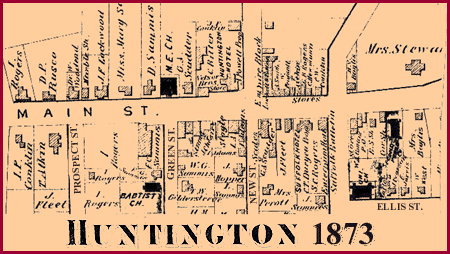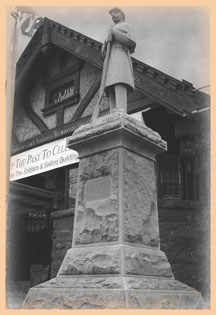Civil War Period and Beyond - History of the Huntington Public
Library
1860's - 1900
| courtesy of the SUNY Stonybrook Historic Postcard Collection |

|
About the time of the Civil War, in one of the many lectures that served as a prime source of entertainment and enlightenment for the community, a Methodist minister told the village that the young people were in need of a library to fill their time with literary pursuits. The Young Men's Literary Association took up this cause with the remaining books from the second library. They gathered 30 members, $200, and 100 volumes and set up in George Sheperd's newspaper office. They never saw their library flourish and being $40 in debt, desolved the association in 1871. They were determined that their books and furniture were public property and refused to sell them to pay their debts.
In 1874 Mrs. Mary J.Talmage (referred to as "Mother of the
Library") visited Lexington Massachusetts and was
impressed with the beautiful library building she saw there. Returning
home, she was determined that Huntington should have a similarly
impressive structure. In the winter of 1875, Mrs. Talmage held a
group discussion in her home on Fairview St. which led to a lecture the
following month in the Assembly rooms by the Rev. A. J. Barrow.
The stated purpose of this
lecture was "to secure funds for the purchase of a Public Library at
Huntington". On February 23, 1875, presided over by Judge J. R. Rolph, a
meeting was held in which the Huntington Library Association was
established. A constitution, prepared by Stephen W. Gaines, was adopted
by the meeting. A month later, at the home of Mrs. Talmage officers
were elected. They included:
- President, Steven W. Gaines
- Vice President, Jarvis R. Rolph
- Treasurer, Arthur T. Hurd
- Secretary, Amos P. Conklin
Miss Mina P. Downs was appointed as the first librarian, succeeded the following year by Miss Ella M. Conklin.
To raise funds this struggling organization gave numerous lectures,
including
one by P.T. Barnum, who spoke on "The Art of Money Making".
They collected
annual and life memberships (the latter as high as $100). With these
funds the association purchased new books and leased a store
from Isaac Adams5 (Isaac Godman4) for housing the
collection. The Honorable Henry J. Scudder donated 30 volumes of great
value and the Young Men's Literary Association presented 162 volumes and
some furniture that had been in storage.

The library remained in the Adams Building until April 1, 1881 when it moved to the Gordon Building in the Empire Block.
On February 1, 1883, drawn up by Henry W. Gaines, Huntington Library Association received its certificate of incorporation.
In the minutes recorded in March 1887, it is stated: "in the room adjoining the library on the East the recently puchased printing press Suffolk Bulletin caused jarring of the building and consequent annoyance. The Library must have a building of its own". Despite this plea, the library remained in rented rooms and again moved eight years later, in April 1889, to the Gardner Building near the Huntington House.
At the end of the Civil War, the town had received donations for the purpose of providing a memorial to those citizens of Huntington that had lost their lives during the war. It was proposed that a library building be incorporated into those memorial plans. Temple Prime was chairman of the Soldier's and Sailors Memorial committee and was a major contributor and supporter of the library's initial construction.
for their dedication to the library and their
particularly resourceful efforts at fundraising. They
had discovered a fine bed of pink arbutus
vine, and year after year, shipped this plant for
sale in New York City. All the proceeds of their
efforts went into the Library treasury. One year, the
amount of the sale was $30.
A large fund raising effort was undertaken, library subscriptions were sought and a massive fair was held in a carriage factory in the Underhill building that lasted several days. The net proceeds of the fair alone were about $1300.
The title for the building site was obtained, without charge, from
the
Town and the First Presbyterian Church and was located next to the Old
Burying Ground, which had played such an important role in Huntingon's
history. The architectural firm of Cady, Berg and See of New York City
submitted plans that were accepted, and construction was
underway in June of 1892. During excavation, a rusted Indian tomahawk
and a slate footstone reading:"Charity Conklin, 1771" were unearthed.

In the later months of 1892, the new Soldiers and Sailors Memorial Building was completed at a cost of just over $10,000. On Jan 19, 1893 the first meeting of the library board was held in its new quarters. Holdings at this time numbered around 3,000 volumes. Furnishings were donated. Shrubs to surround the building were purchased for $5. from Henry Hick's Nursery.
Sometime later, a statue of a Civil War soldier at parade rest was erected outside of the Soldier's and Sailor's Memorial Building. Inside a bronze tablet inscribed with the 36 names of the Huntington men that lost there lives during the war was hung on a wall in the reading room. By an act of Congress in 1896, the War Department donated to the Huntington Grand Army of the Republic, a canon with 5 cannon balls. The cannon balls were from the Watertown Arsenal, and the cannon from Fort Wood, once part of the defenses guarding New York Harbor. These still stand outside the building.
The library was a source of pride for the town, with its fine
Connecticut bluestone exterior and the warmth of a hearth, surrounded by
two armchairs, inside. Of course there also hung, in the reading room,
the
obligatory "No
Talking" sign.
Continue
reading.......the 20th Century history
| "How sweet the silent backward tracings! |
| The wanderings as in dreams - |
| the meditation of old times resumed |
| their loves, joys, persons, voyages" |
| Walt Whitman (1819-1892) |

